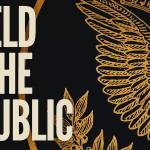
A New Era of Economic Warfare
May 1, 2025
Trump Town Hall Erupts in Laughter as He Claims He’s Made No Mistakes
May 1, 2025Reading has been unfairly maligned as an indoor activity for far too long, in my opinion. As a child, when nice weather came around, I was told to put down my book and go play outside: You can read any old day, adults would say, reminding me that sunshine can be fleeting. The warm days of spring, full of blooming flowers, are certainly worth savoring while you can. But why not bring a book along? Over years of reading outdoors—seated on a park bench, sprawled on a beach blanket—I’ve come to see reading as an experience that, rather than offering an escape from my surroundings, in fact supplements my appreciation of the setting. Turning pages can be an act of mental and sensory enhancement.
This kind of synergy can work two ways. Books can take readers to new places through vivid detail, allowing them to “see” things that might not even exist. At the same time, reading can be a practice in slow, sustained attention, sharpening one’s perception of the trees, the soil, the friends chattering at the next table in the beer garden. The books on this list employ both modes: Some offer intriguing glimpses into faraway places or striking journeys; others meditate on the beauty to be found in a backyard. Crucially, each makes its own case for leaving your reading nook and getting out into the world.
Carpentaria, by Alexis Wright
Great writing has the power to make a place you’ve never visited feel totally familiar. Carpentaria, Wright’s brilliant, surprisingly funny novel, achieves that feat. Its setting, the town of Desperance, situated right below Australia’s Gulf of Carpentaria, is the home of the Waanyi people to which Wright herself belongs. Her detailed attention to the environment—the smell of the sea at low tide, the sound of dingoes outside a cave, the feel of trudging through spinifex in the bush—grounds the book in a strong sense of place. Try listening to Carpentaria as an audiobook; the novel unfolds like an oral epic, more thematic than linear, slowly introducing its characters. We meet Normal Phantom, the gruff seagoing patriarch of the Westside Pricklebush people, and his beautiful, impetuous ex-wife, Angel Day, who seems to stir up trouble just by walking through town. Then there’s Mozzie Fishman, keeper of Aboriginal history and tradition, and Will Phantom, a prodigal son who violently opposes the town’s new mine. Over the span of 500 pages, these people come to feel intensely real, their stories becoming inextricable from their landscape. When I finished, I wasn’t sure what I wanted to do more: visit Queensland myself or reread Carpentaria all over again.


The Living Mountain, by Nan Shepherd
“I am a mountain lover,” writes Shepherd, “because my body is at its best in the rarer air of the heights and communicates its elation to the mind.” Many avid hikers would agree. Shepherd spent most of her life near the Cairngorm mountains of the Scottish highlands, exploring the flora and fauna of the rugged hills as often as possible. The Living Mountain is a compilation of her reflections from “hillwalking.” Written in the 1940s, the manuscript sat in her desk drawer unpublished until 1977—just four years before her death—and it has recently been reissued for American readers. It’s a treasure both as a piece of nature writing about the United Kingdom and as a record of Shepherd’s almost mystical relationship with the landscape: She was not the type to make for the summit and then quickly turn home. Her reflections emerge from unbounded curiosity paired with deep knowledge of the place and its rhythms. Shepherd is a humble but knowledgeable guide, often looking at a familiar peak or loch for so long that she sees it anew. As she writes, “Often the mountain gives itself most completely when I have no destination, when I reach nowhere in particular, but have gone out merely to be with the mountain as one visits a friend with no intention but to be with him.”


Among Flowers: A Walk in the Himalaya, by Jamaica Kincaid
Kincaid’s account of her three-week trek in Nepal—undertaken to collect rare seeds with several botanist friends—is sure to make any reader appreciate their local flora. Kincaid views the Himalayas through the lens of her own home garden in Vermont, searching for plants she can cultivate in the North Bennington climate as her group climbs up through the mountains. I often paused as I read to look up the species she mentions, shocked to see some of the huge plants that grow naturally in alpine zones. She approaches the experience as a true amateur, always ready to learn something new, and her honest reflections on the trip’s difficulties make the book intimate and amusing. Reading Among Flowers feels like traveling alongside Kincaid: You can experience the highs of the journey (gorgeous vistas, rare native-plant sightings, camaraderie and companionship) alongside the lows (leeches, arduous climbs, Maoist guerrilla groups) without ever having to navigate the forbidding range yourself.

By Jamaica Kincaid

Pure Colour, by Sheila Heti
If I could give you one book to read in dappled sunshine, I’d hand you Pure Colour. Heti’s writing is witty, reflective, and just bizarre enough to capture your interest even as people mill about in your peripheral vision. The book is more fable than novel, following a girl named Mira as she grows up, gets a job at a lamp store, and then goes to school to become an art critic, where she falls in love. But things get a bit weirder when Mira’s father, with whom she was especially close, dies. While Mira is grieving, she visits a tree that they both liked, and there, the souls of Mira and her father become literally conjoined in a leaf. Her time in the leaf makes up a short but highly potent part of the novel: Mira and her father enter into a wordless conversation on life, death, grief, and art, until Mira must be coaxed out of the leaf and back into the human world. In Pure Colour, Heti creates a world strange and wild enough to make readers look at their own life with renewed wonder.


The Rings of Saturn, by W. G. Sebald
“In August 1992, when the dog days were drawing to an end, I set off to walk the county of Suffolk, in the hope of dispelling the emptiness that takes hold of me whenever I have completed a long stint of work,” the melancholic, semi-autobiographical narrator of Sebald’s genre-defying novel tells the reader. The Rings of Saturn has a peripatetic form: Not only does it follow a man wandering through Suffolk, but the novel’s action largely lies in the meandering, digressive nature of memory itself. As he crosses the landscape, the narrator finds unexpected connections between the path under his feet and Joseph Conrad’s seafaring days, Dowager Empress Cixi, the silk industry in Norwich, and Rembrandt’s The Anatomy Lesson of Dr. Nicolaes Tulp, among other remembered bits of culture. The Rings of Saturn twists and turns in surprising ways, a reminder that much of what we see around us has its own intricate history, whether remembered or lost.


Devotions, by Mary Oliver
Lots of poets write work that makes one want to go out for a ramble, but Oliver’s poems are particularly motivating. Many of her compositions recount quiet, daily revelations from the biosphere, ones that are experienced through sitting still and looking closely. For Oliver, this is a posture of respect—every bird or small pond or sunset is worthy of acknowledgment and inquiry. She is never sentimental or trite about nature, often dwelling on the death or on the overwhelming darkness of the world. Devotions offers a wide selection of poems from across Oliver’s career: It is a perfect introduction to her work for the uninitiated, but with enough deeper cuts to entertain those who have already memorized “Wild Geese.” Tuck Devotions in a bag and tramp through a wetland or forest, taking a break to read when you’re tired. Don’t feel bad for getting distracted by the bugs or birds around you. As Oliver writes, “When it’s over, I want to say: all my life / I was a bride married to amazement. / I was the bridegroom, taking the world into my arms.”

When you buy a book using a link on this page, we receive a commission. Thank you for supporting The Atlantic.
#Books #Touch #Grass
Thanks to the Team @ The Atlantic Source link & Great Job Bekah Waalkes






